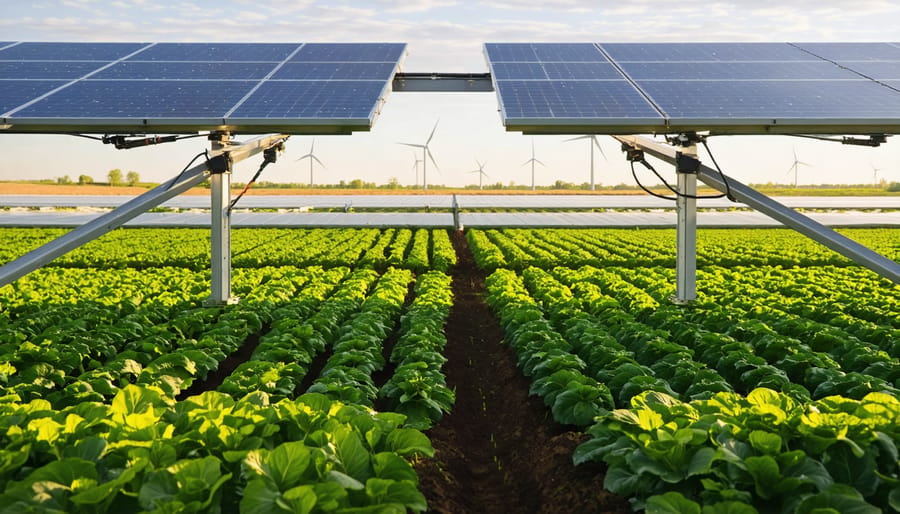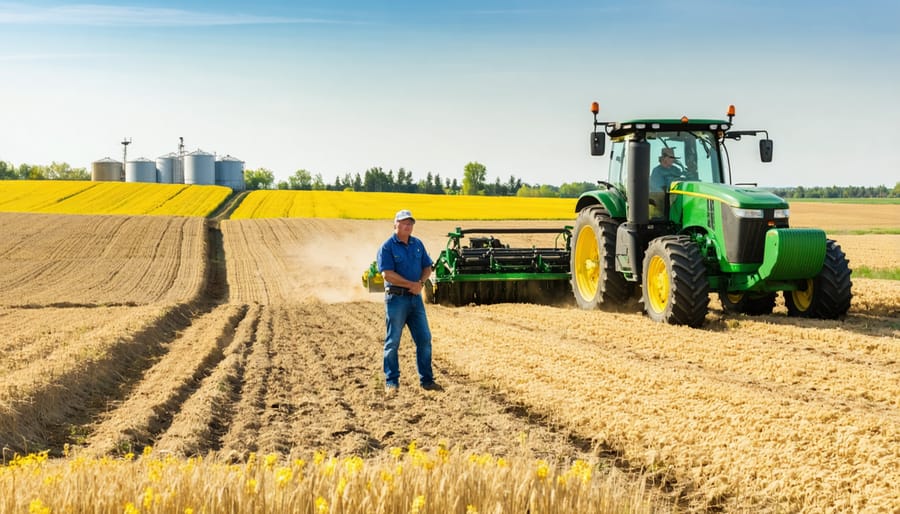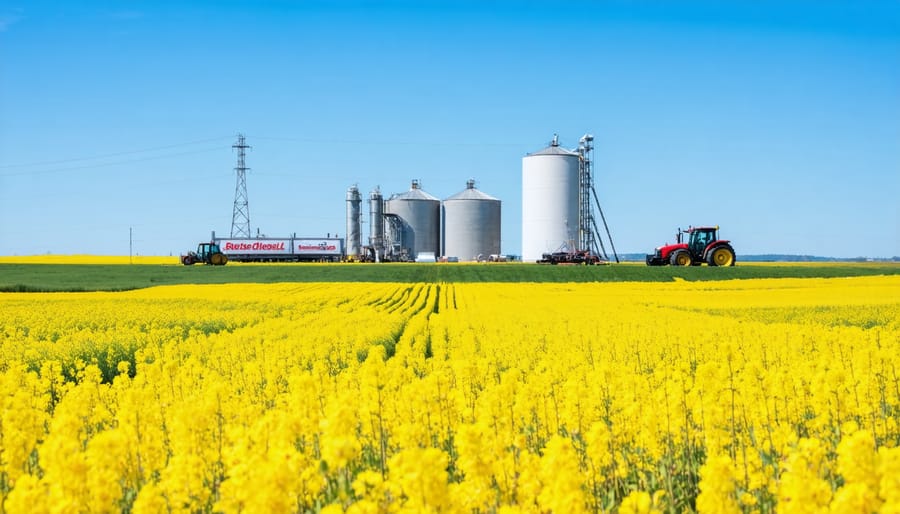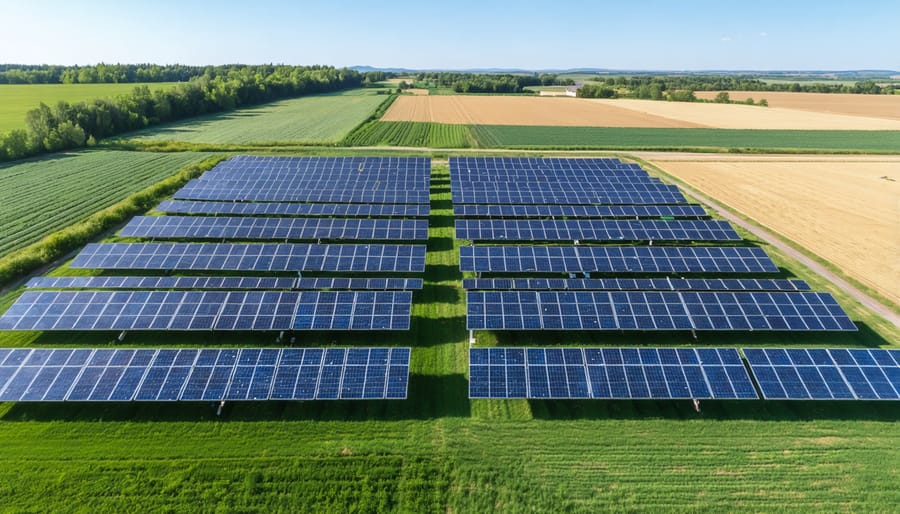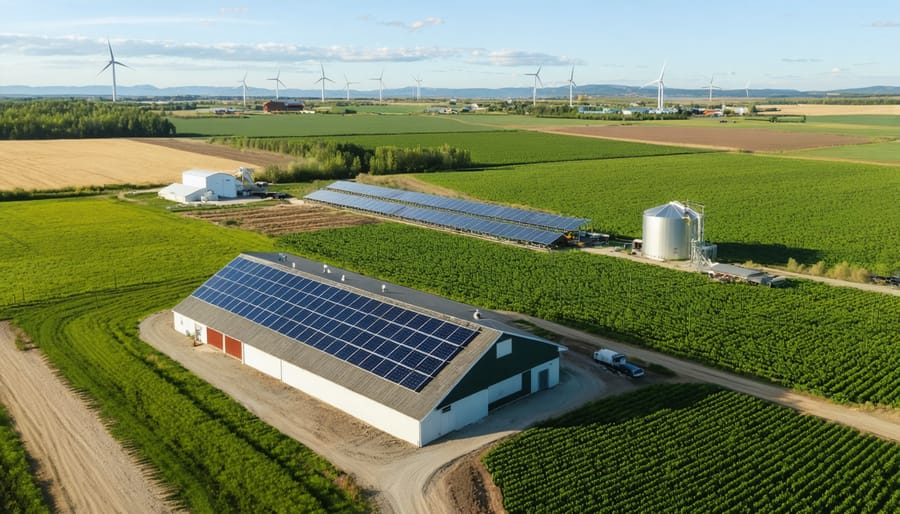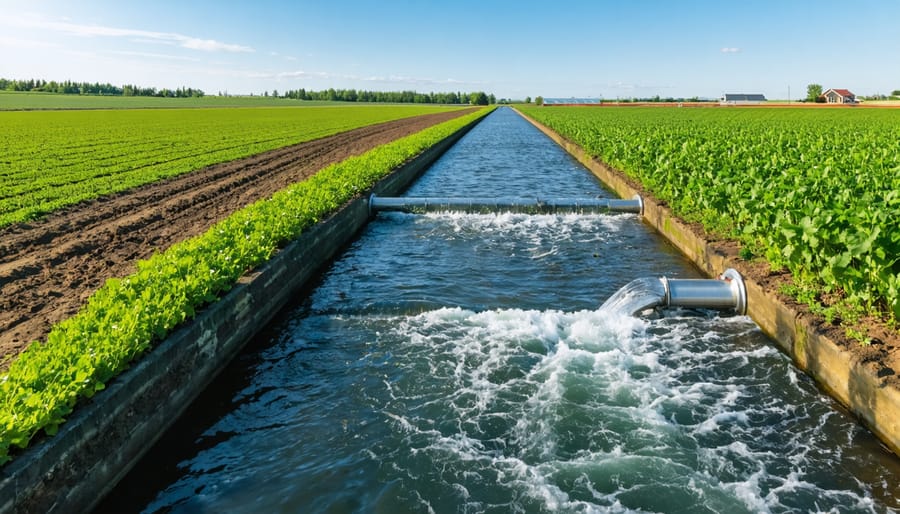Solar farming revolutionizes modern agriculture by merging food production with renewable energy generation through the concept of agrivoltaics. Across Alberta’s vast farmlands, innovative farmers are discovering that harvesting sunlight can be just as profitable as harvesting crops. By mounting solar panels above active agricultural land, producers simultaneously generate clean electricity and maintain productive farming operations, creating two revenue streams from the same acreage. This dual-use approach addresses the growing pressure on agricultural land while supporting Canada’s transition to sustainable energy. For Alberta farmers facing increasing operational costs and unpredictable weather patterns, solar farming offers a resilient solution that combines traditional agricultural expertise with cutting-edge renewable technology. The practice has already shown promising results, with early adopters reporting up to 40% reduction in energy costs while maintaining crop yields and, in some cases, even improving them through optimized shade management and water conservation.
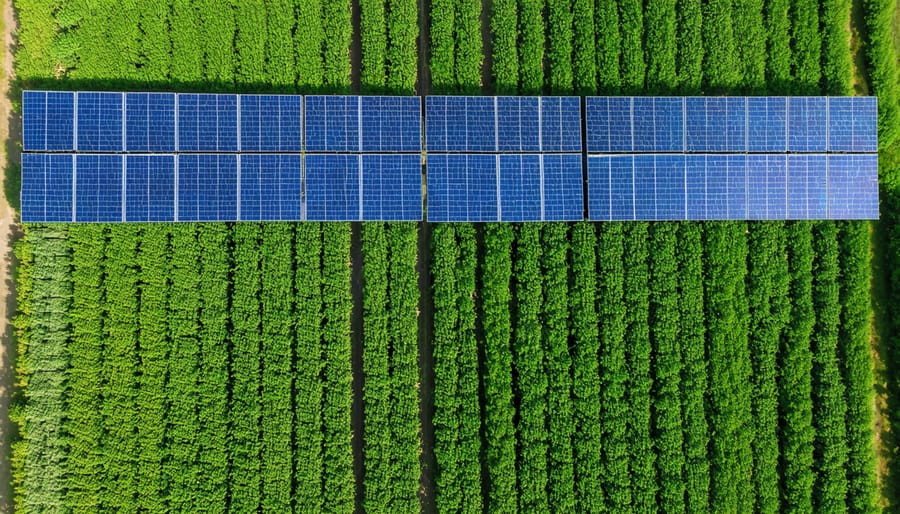
Dual-Purpose Land Use: Growing Crops and Harvesting Sunlight
How Agrivoltaics Work in Alberta’s Climate
In Alberta’s unique climate, agrivoltaic systems require careful planning to maximize both crop yield and solar energy production. Solar panels are typically mounted 3 to 4 metres above the ground, creating a beneficial microclimate underneath. This elevation allows farm equipment to operate freely while providing partial shade that helps reduce water evaporation and protect crops from extreme weather events.
The optimal panel arrangement for our latitude (49-60°N) involves east-west tracking systems, which follow the sun’s path while maintaining consistent light distribution to crops below. Panels are spaced approximately 2 metres apart, allowing about 60% of natural sunlight to reach the crops – an ideal balance for most Alberta-hardy plants.
Crop selection is crucial for successful agrivoltaic operations in our climate. Cold-tolerant crops that thrive in partial shade have shown the best results. These include leafy greens like kale and spinach, root vegetables such as potatoes and carrots, and certain forage crops. Many of these plants actually perform better under the panels’ protective canopy, especially during our hot summer months.
The system’s design must account for snow loads, with panels typically installed at a 35-degree angle to facilitate natural snow shedding. This arrangement has the added benefit of reflecting light onto crops during early spring and late fall, extending the growing season by up to two weeks in some cases.
Selecting Compatible Crops
Selecting the right crops for your agrivoltaic system is crucial for maximizing both energy and agricultural production. Research from Alberta farms has shown increased crop yields with certain shade-tolerant varieties that thrive under solar panels.
Cool-season crops like lettuce, spinach, and kale perform exceptionally well in partial shade conditions, often showing improved quality and extended growing seasons. Root vegetables such as potatoes, carrots, and beets also adapt well to filtered sunlight, while herbs like mint, parsley, and cilantro flourish in these environments.
For grain producers, certain varieties of barley and wheat have demonstrated good performance under solar arrays, particularly during hot summer months when partial shade can reduce heat stress. Forage crops like alfalfa and various grass species are also excellent choices, as they can maintain productivity while benefiting from the moderated microclimate.
Consider consulting with your local agricultural extension office or joining farmer networks in Alberta to learn from others’ experiences with specific crop varieties. Remember to factor in your soil type, local climate conditions, and market demand when making your final crop selection.
Economic Benefits for Alberta Farmers
Government Incentives and Support Programs
Canadian farmers looking to integrate solar energy into their operations can access various government support programs at both federal and provincial levels. In Alberta, the Energy Efficiency Alberta program offers rebates of up to $0.75 per watt for solar PV system installations, significantly reducing initial investment costs. Farmers can typically recover 25-30% of their installation expenses through these incentives.
The Canadian Agricultural Partnership (CAP) provides additional funding opportunities through its Environmental Stewardship stream, offering cost-sharing programs for sustainable farm improvements, including solar installations. Alberta farmers can access up to $50,000 in matching funds for qualifying projects.
Federal tax incentives include the Clean Technology Tax Credit, allowing farms to write off up to 100% of solar equipment costs in the first year. The Canada Greener Homes Grant, while primarily residential, may apply to farm properties with qualifying residential buildings.
Local utilities often provide net metering programs, enabling farmers to earn credits for excess power generated. The Municipal Climate Change Action Centre (MCCAC) also offers region-specific grants and technical support for agricultural solar projects throughout Alberta.
Remember to consult with qualified solar installers and agricultural financial advisors, as program availability and terms may change periodically.
Real Returns: Alberta Farm Case Study
The Anderson family farm in Olds, Alberta, provides a compelling example of successful solar integration in agricultural operations. In 2019, Jim and Sarah Anderson installed a 50-kilowatt solar array on their 640-acre mixed farming operation, covering the south-facing roof of their main equipment barn.
The initial investment of $147,000 was offset by a $35,000 provincial grant, with the remainder financed through a low-interest agricultural loan. Their system generates approximately 66,000 kWh annually, meeting 85% of their farm’s electricity needs, including grain drying operations and workshop power requirements.
“Our electricity bills dropped from $875 to $130 per month on average,” shares Jim. “We’re expecting to recover our investment within seven years, faster than initially projected due to rising energy costs.”
The Andersons report minimal maintenance requirements, with bi-annual panel cleaning coinciding with their regular equipment maintenance schedule. The system has performed reliably through Alberta’s challenging weather conditions, including heavy snowfall and hail, thanks to sturdy mounting systems and quality components.
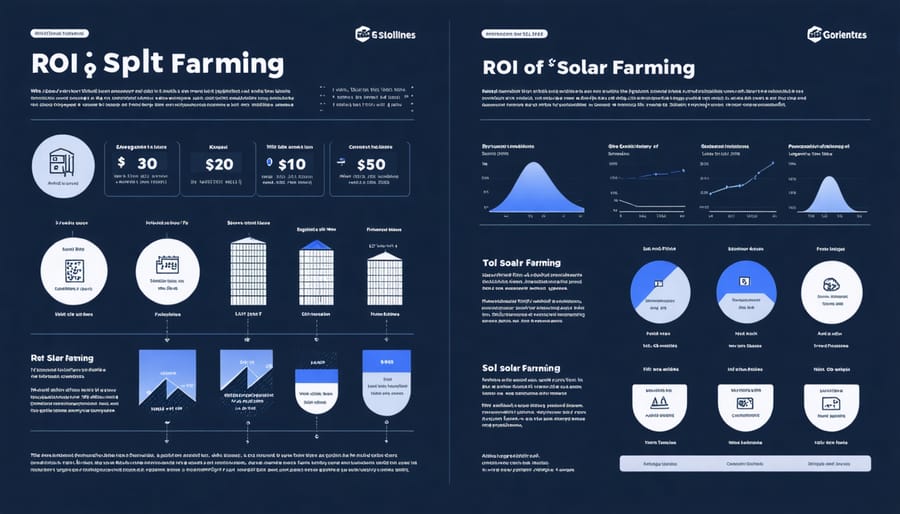
Environmental Impact and Sustainability
Soil Health and Biodiversity Benefits
Solar farming offers remarkable benefits for soil health and biodiversity, complementing sustainable farming practices already familiar to Alberta’s agricultural community. The partial shade created by solar panels helps reduce soil moisture evaporation, particularly beneficial during our hot prairie summers. This improved moisture retention can lead to more stable soil conditions and reduced irrigation needs.
Studies from Canadian research stations show that the areas beneath and between solar panels create diverse microclimates that support different plant species. These varied environments attract beneficial insects, birds, and pollinators, enhancing local biodiversity. Many Alberta farmers have reported increased populations of native bee species and beneficial predatory insects that help control crop pests naturally.
The installation of solar arrays also provides an opportunity for strategic ground cover planting. Many farmers successfully establish native prairie grasses and flowering plants beneath their panels, which improve soil structure through their root systems while providing habitat for local wildlife. This approach helps prevent soil erosion and gradually builds organic matter content, leading to healthier, more resilient agricultural landscapes that benefit both farming operations and local ecosystems.
Implementation Steps for Your Farm
Site Assessment and Planning
Before installing solar panels on your farm, a thorough site assessment is crucial for maximizing energy production and economic benefits. Start by evaluating your property’s solar potential through available sunlight hours and seasonal variations. Southern Alberta farmers typically enjoy excellent solar conditions, with up to 2,300 hours of sunshine annually.
Consider your land’s topography and orientation, aiming for south-facing installations with minimal shading from buildings or trees. Soil conditions and drainage patterns are equally important, especially for ground-mounted systems. Work with local surveyors familiar with Alberta’s agricultural landscape to determine the best placement.
Your farm’s current and future energy needs should guide system sizing. Review past electricity bills and consider upcoming expansions or equipment additions. Connection to the power grid, available infrastructure, and distance to transformers will impact installation costs and feasibility.
Don’t forget to check municipal zoning regulations and obtain necessary permits. Many Alberta counties have specific requirements for agricultural solar installations. Consulting with neighbours early in the planning process can help address concerns and build community support for your project.
Remember to factor in seasonal access requirements for maintenance and the impact on existing farming operations. A well-planned solar installation should complement, not compromise, your agricultural activities.
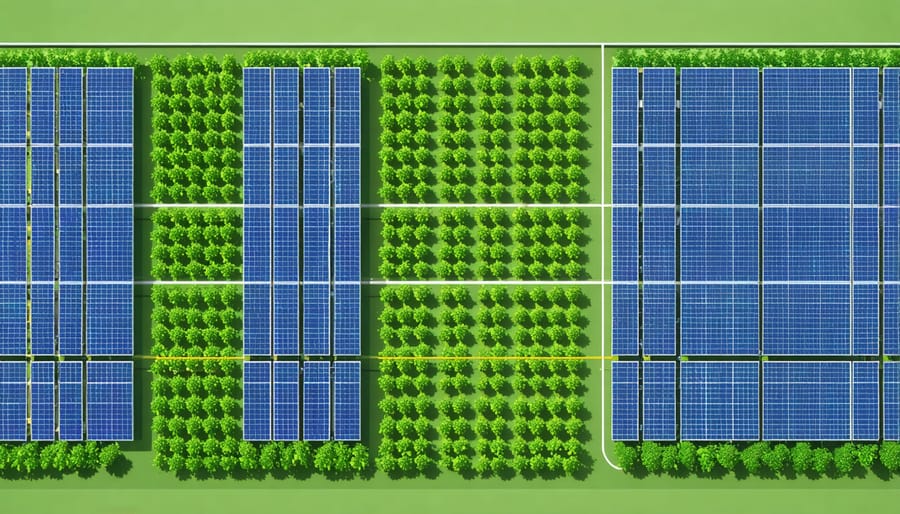
As we’ve explored throughout this guide, solar farming represents a significant opportunity for Canadian agricultural operations to enhance sustainability while maintaining profitability. The combination of declining installation costs, government incentives, and proven success stories across Alberta demonstrates that the time is right for farmers to consider this innovative approach to land use.
By implementing solar energy systems, farms can significantly reduce operational costs, diversify income streams, and contribute to Canada’s clean energy goals. The dual-use potential of agrivoltaics offers particularly exciting possibilities for maintaining agricultural productivity while generating clean power.
Remember that success in solar farming starts with thorough planning, including site assessment, financial analysis, and consultation with local experts. Take advantage of available resources through provincial agricultural offices and renewable energy associations. Connect with fellow farmers who have already embraced solar technology – their experiences provide valuable insights for your journey.
Whether you’re considering a small installation to offset farm electricity costs or exploring larger-scale solar operations, the path to solar farming is clearer than ever. Take the first step today by reaching out to local solar installers or agricultural advisors to discuss your farm’s potential for solar integration.




